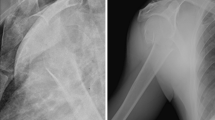Abstract
Percutaneous fixation for proximal humerus fractures is a viable treatment option in selected patients. Advantages over open reduction and internal fixation include less invasive approaches with minimal soft tissue disruption, shorter operating times and respect of biological healing. The surgical technique must be meticulous in order to avoid complications such as pin or screw migration, secondary fracture displacement or infection. Rehabilitation should start two weeks after the surgical procedure, since intrinsic stability of the bone fragments is achieved in a short time.
Similar content being viewed by others
Bibliografia
Buhr AJ, Cooke AM (1959) Fracture patterns. Lancet 1:531–536
Lind T, Krøner K, Jensen J (1989) The epidemiology of fractures of the proximal humerus. Arch Orthop Trauma Surg 108:285–287
Horak J, Nilsson BE (1975) Epidemiology of fracture of the upper end of the humerus. Clin Orthop 112:250–253
Leyshon RL (1984) Closed treatment of fractures of the proximal humerus. Acta Orthop Scand 55:48–51
Taverna E, Sansone V, Battistella F (2004) Arthroscopic treatment for greater tuberosity fractures: rationale and surgical technique. Arthroscopy 20:53–57
Magovern B, Ramsey ML (2008) Percutaneous fixation of proximal humerus fractures. Orthop Clin North Am 39:405–416
Böhler J (1962) Perkutane Osteosynthese mit dem rontgenbildverstarker. Wien Klin Wochenschr 74:485–487
Keener JD, Parsons BO, Flatow EL et al (2007) Outcomes after percutaneous reduction and fixation of proximal humeral fractures. J Shoulder Elbow Surg 16:330–338
Codman EA (1934) The shoulder: Rupture of the supraspinatus tendon and other lesions in or about the subacromial bursa. Thomas Todd, Boston pp 262–293
Neer CS 2nd (1970) Displaced proximal humeral fractures. I. Classification and evaluation J Bone Joint Surg Am 52:1077–1089
Zuckerman JD, Checroun AJ (1999) Fractures of the proximal humerus: diagnosis and management. In: Iannotti JP, Williams GR (Eds) Disorders of the shoulder: diagnosis and management. Lippincott Williams & Wilkins, Philadelphia pp 639–685
Neer CS 2nd, Rockwood CA (1984) Fractures and dislocations of the shoulder. In Rockwood CA, Green DP (Eds) Fractures, 2nd ed. Lippincott Williams & Wilkins, Philadelphia pp 675–707
Jakob RP, Miniaci A, Anson PS (1991) Four-part valgus impacted fractures of the proximal humerus. J Bone Joint Surg Br 73:295–298
Resch H, Povacz P, Fröhlich R, Wambacher M (1997) Percutaneous fixation of three- and four-part fractures of the proximal humerus. J Bone Joint Surg Br 79:295–300
Galatz LM (2007) Percutaneous pinning for surgical neck fracture: method of choice-affirms. Semin Arthroplasty 18:1–22
Grassi FA, Tajana MS (2006) Fratture dell’estremo prossimale dell’omero. In Fornara P, Stecco A, Carriero A et al (Eds) Spalla. Testo atlante di clinica, imaging, patologia e riabilitazione. Idelson-Gnocchi, Napoli pp 327–338
Morris MF, Kilcoyne RF, Shuman W (1987) Humeral tuberosity fractures: evaluation by CT scan and management of malunion. Orthop Transactions 11:242–247
Jaberg H, Warner JJ, Jakob RP (1992) Percutaneous stabilization of unstable fractures of the humerus. J Bone Joint Surg Am 74:508–515
Mazet R (1943) Migration of a Kirschner wire from the shoulder region into the lung. J Bone Joint Surg 25:477–483
Aalders GJ, van Vroonhoven TJ, van der Werken C, Wijffels CC (1985) An exceptional case of pneumothorax. “A new adventure of the K wire”. Injury 16:564–565
Bedi GS, Gill SS, Singh M, Lone GN (1997) Intrathoracic migration of a Kirschner wire: case report. J Trauma 43:865–866
Leppilahti J, Jalovaara P (1999) Migration of Kirschner wires following fixation of the clavicle: a report of 2 cases. Acta Orthop Scand 70:517–519
Daus GP, Drez D Jr, Newton BB Jr, Kober R (1993) Migration of a Kirschner wire from the sternum to the right ventricle. A case report. Am J Sports Med 21:321–322
Demaria R, Picard E, Bodino M et al (1998) Migration of a clavicular bone wire acutely perforating the ascending aorta. Presse Med 27:1013
Combalía-Aleu A, García S (1994) Pulmonary artery perforation after Kirschner wire migration: case report and review of literature. J Trauma 37:514–515
Retief PJ, Meintjes FA (1978) Migration of a Kirschner wire in the body. A case report. S Afr Med J 53:557–558
Rowles DJ, McGrory JE (2001) Percutaneous pinning of the proximal part of the humerus. An anatomic study. J Bone Joint Surg Am 83:1695–1699
Kamineni S, Ankem H, Sanghavi S (2004) Anatomical considerations for percutaneous proximal humeral fracture fixation. Injury 35:1133–1136
Hertel R, Hempfing A, Stiehler M, Leunig M (2004) Predictors of humeral head ischemia after intracapsular fracture of the proximal hunerus. J Shoulder Elbow Surg 13:427–433
Soete PJ, Clayson PE, Costenoble VH (1999) Transitory percutaneous pinning in fractures of the proximal humerus. J Shoulder Elbow Surg 8:569–573
Author information
Authors and Affiliations
Rights and permissions
About this article
Cite this article
Fornara, P., Grassi, F.A. Fratture dell’omero prossimale. La sintesi percutanea: ha ancora un ruolo?. LO SCAL 23, 12–17 (2009). https://doi.org/10.1007/s11639-009-0016-z
Published:
Issue Date:
DOI: https://doi.org/10.1007/s11639-009-0016-z




